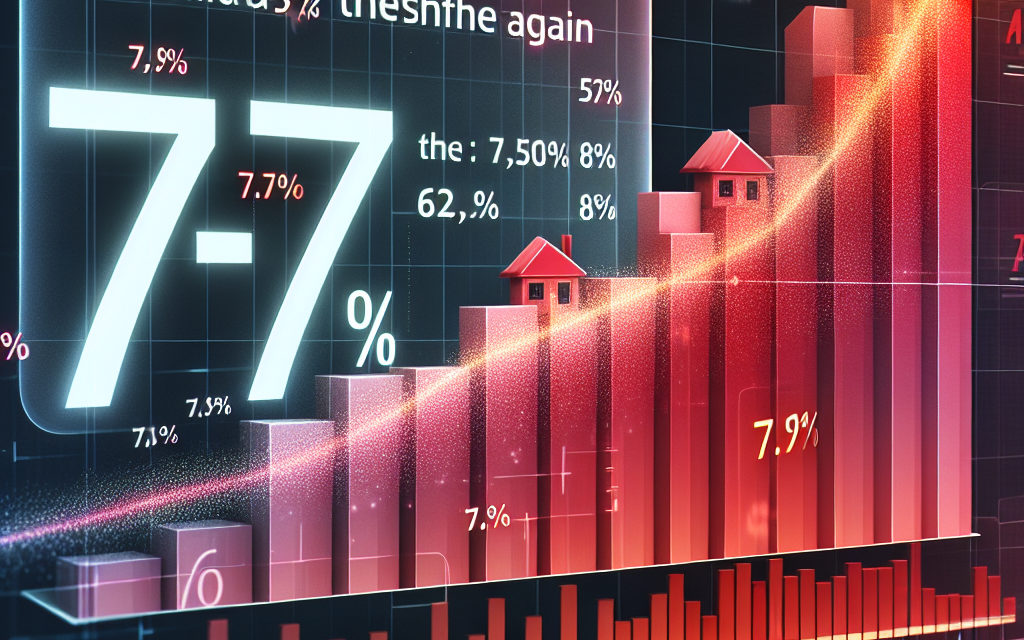“Mortgage Rates Climb Back to 7%: A New Challenge for Homebuyers.”
Introduction
Mortgage rates are once again approaching the critical 7% threshold, marking a significant shift in the housing market landscape. This surge is driven by a combination of factors, including rising inflation, shifts in Federal Reserve monetary policy, and increased demand for housing amid limited inventory. As potential homebuyers face higher borrowing costs, the implications for affordability and housing market dynamics are profound, prompting many to reassess their purchasing strategies and financial plans. The resurgence of rates near this psychological barrier raises concerns about the sustainability of the housing recovery and the broader economic impact on consumers and the real estate sector.
Current Trends in Mortgage Rates
In recent weeks, mortgage rates have surged towards the 7% threshold once again, marking a significant shift in the housing market landscape. This upward trend is primarily influenced by a combination of economic factors, including inflationary pressures, Federal Reserve policies, and broader market dynamics. As prospective homebuyers and current homeowners alike navigate this evolving environment, understanding the implications of rising mortgage rates becomes increasingly crucial.
To begin with, the Federal Reserve’s ongoing efforts to combat inflation have played a pivotal role in shaping mortgage rates. In response to persistent inflationary trends, the Fed has implemented a series of interest rate hikes aimed at stabilizing the economy. These adjustments have a direct impact on mortgage rates, as lenders often adjust their rates in anticipation of changes in the federal funds rate. Consequently, as the Fed signals its commitment to curbing inflation, mortgage rates have followed suit, inching closer to the 7% mark.
Moreover, the current economic climate has contributed to heightened uncertainty, further influencing mortgage rates. Investors are closely monitoring economic indicators, such as employment figures and consumer spending, which can signal the overall health of the economy. When economic data suggests potential slowdowns or instability, investors may seek safer assets, leading to fluctuations in mortgage-backed securities. This volatility can result in increased mortgage rates, as lenders adjust their pricing to account for perceived risks in the market.
In addition to these macroeconomic factors, the housing market itself is experiencing notable shifts. With rising mortgage rates, many potential homebuyers are finding themselves priced out of the market or reconsidering their purchasing decisions. This has led to a slowdown in home sales, as buyers weigh the long-term implications of higher borrowing costs. As demand softens, some sellers may be compelled to lower their asking prices, creating a more favorable environment for buyers who remain in the market. However, this dynamic also raises concerns about the overall health of the housing market, as sustained high rates could lead to a more pronounced decline in home sales and prices.
Furthermore, the impact of rising mortgage rates extends beyond just homebuyers; it also affects current homeowners looking to refinance. With rates approaching 7%, many homeowners may find it less advantageous to refinance their existing mortgages, particularly if they secured lower rates in previous years. This reluctance to refinance can lead to a decrease in overall mortgage activity, further contributing to the cooling of the housing market.
As we look ahead, it is essential to consider how these trends may evolve. Analysts predict that mortgage rates could continue to fluctuate in response to economic developments and Federal Reserve actions. Homebuyers and homeowners alike must remain vigilant, staying informed about market conditions and potential rate changes. For those considering purchasing a home or refinancing, it may be prudent to consult with financial advisors or mortgage professionals to explore the best options available in this challenging environment.
In conclusion, the surge in mortgage rates towards the 7% threshold reflects a complex interplay of economic factors and market dynamics. As the landscape continues to shift, understanding these trends will be vital for anyone involved in the housing market. Whether one is a prospective buyer, a current homeowner, or an industry professional, staying informed and adaptable will be key to navigating the challenges posed by rising mortgage rates.
Impact of Rising Mortgage Rates on Homebuyers
As mortgage rates surge towards the 7% threshold once again, the implications for homebuyers are significant and multifaceted. The increase in borrowing costs can dramatically alter the landscape of home purchasing, affecting affordability, buyer sentiment, and overall market dynamics. For many prospective homeowners, the prospect of higher rates can be daunting, as it directly impacts monthly mortgage payments and the total cost of homeownership over time.
To begin with, rising mortgage rates typically lead to higher monthly payments for homebuyers. For instance, a 1% increase in the interest rate can add hundreds of dollars to a monthly mortgage payment, depending on the loan amount. This increase can push some potential buyers out of the market entirely, particularly first-time homebuyers who may already be struggling to save for a down payment. Consequently, as rates climb, the pool of eligible buyers may shrink, leading to a slowdown in home sales and potentially affecting home prices.
Moreover, the psychological impact of rising rates cannot be overlooked. As mortgage rates approach the 7% mark, many buyers may feel a sense of urgency to purchase before rates rise even further. This urgency can lead to increased competition among buyers, particularly in desirable neighborhoods. However, for some, the fear of overextending financially may lead to hesitation, causing them to delay their home purchase. This duality of urgency and caution can create a volatile market environment, where some buyers are eager to act while others remain on the sidelines.
In addition to affecting individual buyers, rising mortgage rates can also have broader implications for the housing market as a whole. Higher rates can lead to a decrease in home affordability, which may result in a slowdown in home price appreciation. In markets where prices have been rising rapidly, the combination of higher rates and reduced buyer demand could lead to a stabilization or even a decline in home values. This shift could be particularly pronounced in areas that have seen speculative buying or where home prices have outpaced income growth.
Furthermore, the impact of rising mortgage rates extends beyond just the immediate effects on homebuyers. It can also influence the decisions of builders and developers. As financing costs increase, developers may become more cautious in their projects, potentially leading to a slowdown in new construction. This reduction in supply could exacerbate existing housing shortages, particularly in markets where demand remains strong despite rising rates. Consequently, the interplay between mortgage rates, buyer behavior, and housing supply can create a complex web of influences that shape the market.
In conclusion, the surge in mortgage rates towards the 7% threshold presents a challenging environment for homebuyers. The immediate financial implications, coupled with the psychological effects of rising rates, can significantly alter buyer behavior and market dynamics. As affordability becomes a pressing concern, the housing market may experience shifts that could reshape the landscape for both buyers and sellers. Ultimately, understanding these impacts is crucial for anyone navigating the current real estate environment, as the decisions made today will have lasting consequences in the evolving housing market.
Historical Context of Mortgage Rate Fluctuations
Mortgage rates have long been a critical factor influencing the housing market, and their fluctuations can significantly impact both buyers and sellers. To understand the current surge towards the 7% threshold, it is essential to consider the historical context of mortgage rate movements. Over the past several decades, mortgage rates have experienced considerable volatility, shaped by various economic conditions, government policies, and market dynamics.
In the late 1970s and early 1980s, the United States faced rampant inflation, which prompted the Federal Reserve to implement aggressive monetary policies. As a result, mortgage rates soared, peaking at an astonishing 18.63% in October 1981. This unprecedented spike had profound implications for the housing market, as many potential buyers were priced out, leading to a significant slowdown in home sales and construction. The high rates of that era serve as a stark reminder of how economic factors can drastically alter the landscape of home financing.
As the 1980s progressed, inflation began to subside, and the Federal Reserve shifted its focus towards stimulating economic growth. Consequently, mortgage rates gradually declined throughout the late 1980s and into the 1990s, reaching a low of around 7.5% by the end of the decade. This decline made homeownership more accessible for many Americans, contributing to a housing boom that characterized the late 1990s and early 2000s. The favorable borrowing conditions encouraged a surge in home purchases and refinances, ultimately leading to a significant increase in housing prices.
However, the early 2000s brought about a new set of challenges. The housing market experienced a dramatic expansion fueled by subprime lending and speculative investments. As demand for housing skyrocketed, so did home prices, creating an unsustainable bubble. By 2006, mortgage rates had risen again, hovering around 6.5%. The subsequent collapse of the housing market in 2007 and 2008 led to a financial crisis that resulted in widespread foreclosures and a severe recession. In response, the Federal Reserve implemented unprecedented measures, including lowering interest rates to near-zero levels and introducing quantitative easing programs to stimulate the economy.
These actions had a profound impact on mortgage rates, which plummeted to historic lows in the following years. By 2012, rates had dipped below 3.5%, making homeownership more attainable than ever. This environment fostered a recovery in the housing market, as buyers rushed to take advantage of the low borrowing costs. However, as the economy began to recover, the Federal Reserve signaled its intention to gradually raise interest rates, leading to a slow but steady increase in mortgage rates throughout the mid-2010s.
As we approach the current surge towards the 7% threshold, it is crucial to recognize the interplay of various factors at play. Inflationary pressures, supply chain disruptions, and geopolitical tensions have all contributed to the recent uptick in rates. Additionally, the Federal Reserve’s commitment to combating inflation through interest rate hikes has further influenced mortgage rates. As history has shown, these fluctuations can have far-reaching consequences for the housing market, affecting affordability, buyer sentiment, and overall economic stability. Understanding this historical context allows us to better navigate the complexities of the current mortgage landscape and anticipate the potential implications for the future.
Strategies for Homebuyers in a High-Rate Environment
As mortgage rates surge towards the 7% threshold once again, homebuyers are faced with a challenging landscape that requires strategic planning and informed decision-making. In this high-rate environment, potential buyers must adapt their approaches to home purchasing to mitigate the impact of elevated borrowing costs. One of the first strategies to consider is enhancing one’s financial profile. This can be achieved by improving credit scores, which play a crucial role in determining the interest rates offered by lenders. A higher credit score not only increases the likelihood of securing a mortgage but can also lead to more favorable terms, ultimately reducing the overall cost of borrowing.
In addition to bolstering credit scores, homebuyers should also explore various loan options available in the market. While fixed-rate mortgages are often the most popular choice, adjustable-rate mortgages (ARMs) may present a viable alternative for some buyers. ARMs typically offer lower initial rates, which can be particularly appealing in a high-rate environment. However, it is essential for buyers to carefully assess their long-term plans and risk tolerance, as these loans can lead to increased payments if rates rise significantly in the future. Therefore, understanding the nuances of different mortgage products is vital for making an informed decision.
Moreover, homebuyers should consider the timing of their purchase. In a fluctuating market, waiting for a potential dip in rates could be advantageous, but it is crucial to balance this with the risk of rising home prices. Engaging with a knowledgeable real estate agent can provide valuable insights into market trends and help buyers identify the right moment to enter the market. Additionally, buyers should remain flexible in their home search criteria. Expanding the geographical area of interest or considering different property types can open up more opportunities, especially in a competitive market where inventory may be limited.
Another effective strategy involves leveraging down payment assistance programs or grants that may be available at the local or state level. These programs can significantly reduce the financial burden on homebuyers, making it easier to navigate the high-rate environment. Furthermore, buyers should not hesitate to negotiate with sellers. In a market where mortgage rates are high, sellers may be more willing to offer concessions, such as covering closing costs or providing credits for repairs, which can alleviate some of the financial pressure on buyers.
Additionally, it is prudent for homebuyers to conduct thorough research and seek pre-approval from lenders. Pre-approval not only provides a clearer picture of what one can afford but also strengthens a buyer’s position when making an offer. In a competitive market, having pre-approval can signal to sellers that the buyer is serious and financially capable, potentially giving them an edge over other offers.
Lastly, maintaining a long-term perspective is essential. While the current high-rate environment may seem daunting, it is important to remember that mortgage rates fluctuate over time. Homebuyers should focus on their overall financial goals and consider the purchase as a long-term investment rather than a short-term decision. By employing these strategies, homebuyers can navigate the complexities of a high-rate environment with greater confidence and ultimately secure a home that meets their needs and aspirations.
Predictions for Future Mortgage Rate Movements
As mortgage rates continue to hover near the 7% threshold, many industry experts and analysts are closely monitoring the economic indicators that could influence future movements in these rates. The recent surge in mortgage rates has raised concerns among potential homebuyers and those looking to refinance, prompting a deeper examination of the factors that could shape the trajectory of these rates in the coming months.
One of the primary drivers of mortgage rates is the Federal Reserve’s monetary policy, particularly its stance on interest rates. In response to persistent inflationary pressures, the Fed has implemented a series of interest rate hikes aimed at curbing inflation. As the central bank continues to navigate this complex economic landscape, its decisions will play a crucial role in determining the direction of mortgage rates. If inflation remains stubbornly high, further rate increases may be necessary, which could push mortgage rates even higher. Conversely, if inflation shows signs of abating, the Fed may adopt a more dovish approach, potentially stabilizing or even lowering mortgage rates.
In addition to the Fed’s actions, broader economic conditions will also influence mortgage rate movements. Economic growth, employment rates, and consumer confidence are all interconnected factors that can impact the housing market. For instance, if the economy continues to expand and job growth remains robust, demand for housing may increase, putting upward pressure on mortgage rates. On the other hand, if economic indicators begin to show signs of weakness, such as rising unemployment or declining consumer spending, this could lead to a decrease in demand for housing, which may help to stabilize or lower mortgage rates.
Moreover, geopolitical events and global economic trends can also have a significant impact on mortgage rates. For example, ongoing tensions in various regions or shifts in international trade policies can create uncertainty in financial markets, leading investors to seek safer assets such as U.S. Treasury bonds. When demand for these bonds increases, their yields typically decrease, which can result in lower mortgage rates. Therefore, monitoring global events and their potential ramifications on the U.S. economy is essential for understanding future mortgage rate movements.
Another important consideration is the housing supply and demand dynamics. The current housing market is characterized by a shortage of available homes, which has driven prices upward. If this trend continues, it may deter potential buyers, leading to a slowdown in the housing market. A cooling housing market could prompt lenders to lower mortgage rates in an effort to stimulate demand. Conversely, if new construction picks up and inventory levels rise, this could lead to increased competition among sellers, potentially stabilizing home prices and influencing mortgage rates.
In conclusion, the future movements of mortgage rates are contingent upon a multitude of factors, including the Federal Reserve’s monetary policy, economic conditions, geopolitical events, and housing market dynamics. As these elements evolve, they will collectively shape the landscape of mortgage rates, impacting both current homeowners and prospective buyers. While predictions can be challenging in such a fluid environment, staying informed about these key indicators will be essential for anyone navigating the complexities of the mortgage market in the months ahead.
The Role of Inflation in Mortgage Rate Increases
As mortgage rates surge towards the 7% threshold once again, it is essential to understand the underlying factors contributing to this trend, particularly the role of inflation. Inflation, defined as the rate at which the general level of prices for goods and services rises, erodes purchasing power and influences various economic indicators, including interest rates. When inflation rises, central banks, such as the Federal Reserve in the United States, often respond by increasing interest rates to curb spending and stabilize the economy. This response is crucial in understanding the current landscape of mortgage rates.
To begin with, the relationship between inflation and mortgage rates is inherently linked to the broader economic environment. When inflation is high, lenders anticipate that the purchasing power of the money they lend will decrease over time. Consequently, they demand higher interest rates to compensate for this risk. As a result, potential homebuyers may find themselves facing increased borrowing costs, which can significantly impact their ability to purchase a home. This dynamic creates a ripple effect throughout the housing market, as higher mortgage rates can lead to decreased demand for homes, ultimately affecting home prices.
Moreover, the expectations surrounding future inflation play a pivotal role in shaping mortgage rates. If consumers and investors believe that inflation will continue to rise, they may adjust their behavior accordingly. For instance, lenders may preemptively raise mortgage rates in anticipation of future inflationary pressures. This phenomenon can create a self-fulfilling cycle, where expectations of inflation lead to higher rates, which in turn can dampen economic activity and further exacerbate inflationary concerns. Thus, the interplay between inflation expectations and mortgage rates becomes a critical consideration for both borrowers and lenders.
In addition to influencing borrowing costs, inflation also affects the overall economic landscape, including employment and wage growth. When inflation is high, central banks may implement tighter monetary policies, which can slow down economic growth and potentially lead to higher unemployment rates. This scenario can create a challenging environment for prospective homebuyers, as job security and income stability are vital factors in the decision to purchase a home. As mortgage rates rise in response to inflation, the affordability of homes diminishes, further complicating the housing market dynamics.
Furthermore, the impact of inflation on mortgage rates is not uniform across all types of loans. Fixed-rate mortgages, for instance, are particularly sensitive to inflationary trends, as borrowers lock in their rates for the duration of the loan. Conversely, adjustable-rate mortgages may initially offer lower rates but can become more expensive over time as interest rates rise in response to inflation. This distinction highlights the importance of understanding the nuances of different mortgage products in the context of an inflationary environment.
In conclusion, the surge in mortgage rates towards the 7% threshold is intricately linked to the role of inflation in the economy. As inflation rises, so too do the expectations and responses from lenders, resulting in higher borrowing costs for homebuyers. This relationship underscores the importance of monitoring inflation trends and their potential impact on the housing market. As prospective buyers navigate this challenging landscape, understanding the interplay between inflation and mortgage rates will be crucial in making informed decisions about homeownership.
Refinancing Options Amidst Rising Mortgage Rates
As mortgage rates continue to surge towards the 7% threshold, homeowners are increasingly seeking refinancing options to alleviate the financial burden associated with higher borrowing costs. The recent uptick in rates has prompted many to reassess their current mortgage agreements, particularly those who secured loans at lower rates in previous years. This situation presents both challenges and opportunities for homeowners, as they navigate the complexities of refinancing in a fluctuating market.
One of the primary motivations for refinancing is to secure a lower interest rate, which can lead to significant savings over the life of the loan. However, with rates approaching 7%, the prospect of obtaining a more favorable rate may seem daunting. Nevertheless, homeowners should consider the potential benefits of refinancing, even in a rising rate environment. For instance, those with adjustable-rate mortgages (ARMs) may find it advantageous to switch to a fixed-rate mortgage, thereby locking in a stable rate and protecting themselves from future increases. This strategy can provide peace of mind, especially for those who plan to stay in their homes for an extended period.
In addition to securing a lower rate, refinancing can also offer the opportunity to access home equity. As property values have generally appreciated over the past few years, many homeowners may find themselves in a position to tap into their equity for various purposes, such as funding home improvements, consolidating debt, or covering educational expenses. By refinancing, homeowners can potentially convert their equity into cash while simultaneously adjusting their mortgage terms to better suit their financial goals.
Moreover, it is essential for homeowners to evaluate their current financial situation and long-term objectives before proceeding with refinancing. Factors such as credit score, debt-to-income ratio, and overall financial health play a crucial role in determining eligibility for refinancing and the rates available. Homeowners with strong credit profiles may still qualify for competitive rates, even as the market shifts. Therefore, it is advisable to review credit reports and address any discrepancies or outstanding debts prior to initiating the refinancing process.
Additionally, the costs associated with refinancing should not be overlooked. Closing costs, which can range from 2% to 5% of the loan amount, may offset some of the potential savings from a lower interest rate. Homeowners should conduct a thorough cost-benefit analysis to ensure that refinancing aligns with their financial objectives. In some cases, it may be more prudent to maintain the current mortgage, particularly if the existing rate is significantly lower than prevailing market rates.
Furthermore, it is crucial to stay informed about market trends and economic indicators that may influence mortgage rates. The Federal Reserve’s monetary policy decisions, inflation rates, and overall economic conditions can all impact borrowing costs. By keeping abreast of these developments, homeowners can make more informed decisions regarding refinancing and timing.
In conclusion, while rising mortgage rates present challenges for homeowners considering refinancing, there are still viable options available. By carefully evaluating their financial circumstances, exploring different mortgage products, and staying informed about market conditions, homeowners can navigate the complexities of refinancing effectively. Ultimately, the goal is to find a solution that not only addresses immediate financial concerns but also supports long-term financial stability and growth.
Q&A
1. **Question:** What is the current trend in mortgage rates as of October 2023?
**Answer:** Mortgage rates are surging towards the 7% threshold again.
2. **Question:** What factors are contributing to the rise in mortgage rates?
**Answer:** Factors include inflation concerns, Federal Reserve interest rate hikes, and economic uncertainty.
3. **Question:** How does a rise in mortgage rates affect homebuyers?
**Answer:** Higher mortgage rates increase monthly payments, making homes less affordable for buyers.
4. **Question:** What impact do rising mortgage rates have on the housing market?
**Answer:** Rising rates can lead to decreased home sales and slower price growth as affordability declines.
5. **Question:** Are there any predictions for future mortgage rate trends?
**Answer:** Analysts suggest that rates may continue to fluctuate based on economic conditions and Federal Reserve policies.
6. **Question:** How do current mortgage rates compare to historical averages?
**Answer:** Current rates around 7% are significantly higher than the historical lows seen in recent years.
7. **Question:** What should potential homebuyers consider in light of rising mortgage rates?
**Answer:** Buyers should assess their budget, consider locking in rates, and explore different financing options.
Conclusion
Mortgage rates have surged towards the 7% threshold again, reflecting ongoing economic pressures such as inflation and Federal Reserve policies. This increase may impact home affordability, dampening buyer demand and slowing the housing market. As rates rise, potential homebuyers may face challenges in securing financing, while existing homeowners may reconsider refinancing options. Overall, the surge in mortgage rates signals a complex landscape for the real estate market, with implications for both buyers and sellers.





